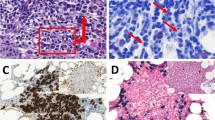Abstract
We have evaluated the use of CD138+ positively selected bone marrow samples to identify a molecular target for minimal residual disease assessment by polymerase chain reaction (PCR) in 25 untreated patients with multiple myeloma. A fraction of each sample was used for CD138+ selection, and the rest served as a reference control. VDJH, DJH, and Kde gene rearrangements were tested for amplification according to the BIOMED-2 Concerted Action. PCR products were directly sequenced in an automated ABI 3130 DNA sequencer using Big-Dye terminators. Within the CD138+ selected group, VDJH rearrangements were detected in all cases (100 %), DJH in 16 (64 %), and Kde in 18 (72 %) cases; whereas in the control samples, VDJH, DJH, and Kde rearrangements were detected in 19 (76 %), 11 (44 %), and 12 (48 %) cases, respectively. After sequencing, 24 (96 %) cases within the CD138+ group had a PCR target for MRD detection compared with 15 (60 %) cases in the control group. We conclude that the use of CD138+ positively selected bone marrow samples increases the applicability of minimal residual disease studies by PCR in patients with multiple myeloma.
Similar content being viewed by others
References
Chanan-Khan AA, Giralt S (2010) Importance of achieving a complete response in multiple myeloma, and the impact of novel agents. J Clin Oncol 28:2612–2624
Rajkumar SV, Harousseau JL, Durie B, Anderson KC et al (2011) Consensus recommendations for the uniform reporting of clinical trials: report of the International Myeloma Workshop Consensus Panel 1. Blood 117(18):4691–4695
Paiva B, Vidriales MB, Cerveró J, Mateo G et al (2008) Multiparameter flow cytometry is the most relevant prognostic factor for multiple myeloma patients who undergo autologous stem cell transplantation. Blood 112:4017–40213
Martínez-Sánchez P, Montejano L, Sarasquete ME, García-Sanz R et al (2008) Evaluation of minimal residual disease in multiple myeloma patients by fluorescent-PCR: the prognostic impact of achieving molecular response. Br J Haematol 142:766–774
Sarasquete ME, García-Sanz R, González D, Martínez J et al (2005) Minimal residual disease monitoring in multiple myeloma: a comparison between allelic specific real-time oligonucleotide polymerase quantitative and flow cytometry. Haematologica 90:1365–1372
Ladetto M, Pagliano A, Ferrero S, Cavallo F et al (2010) Major tumor shrinking and persistent molecular remissions after consolidation with bortezomib, thalidomide, and dexamethasone in patients with autografted myeloma. J Clin Oncol 28(12):2077–2084
van Dongen JJM, Langerak AW, Brüggemann M, Evans PAS et al (2003) Design and standardization of PCR primers and protocols for detection of clonal immunoglobulin and T-cell receptor gene recombinations in suspect lymphoproliferations: report of the BIOMED-2 Concerted Action BMH4-CT98-3936. Leukemia 17:2257–2317
Martinelli G, Terragna C, Zamagni E, Ronconi S et al (2000) Molecular remission after allogeneic or autologous transplantation of hematopoietic stem cells for multiple myeloma. J Clin Oncol 18(11):2273–2281
Acknowledgments
The authors thank Phil Mason for checking the English usage and grammar of the manuscript and Alicia Antón for her technical assistance. This work has been partially supported by the grant number PS09/01450 from the Spanish Fondo de Investigaciones Sanitarias. N. Puig was partially supported by a grant from the Sociedad Española de Hematología y Hemoterapia.
Conflict of Interest
The authors declare that they have no conflicts of interest.
Author information
Authors and Affiliations
Corresponding author
Rights and permissions
About this article
Cite this article
Puig, N., Sarasquete, M.E., Alcoceba, M. et al. The use of CD138 positively selected marrow samples increases the applicability of minimal residual disease assessment by PCR in patients with multiple myeloma. Ann Hematol 92, 97–100 (2013). https://doi.org/10.1007/s00277-012-1566-3
Received:
Accepted:
Published:
Issue Date:
DOI: https://doi.org/10.1007/s00277-012-1566-3




